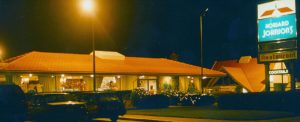Farewell to HoJo’s, a Futterman family favorite
Published June 9, 2022
You know how sometimes you see a headline, or catch a snippet on the TV news and bam, you’re transported back in time? Often, it’s the innocuous stuff that does it, something you haven’t thought about for decades. But then, once that headline or snippet enters your consciousness, it’s all you can think about. That happened to me last week when I read that the last Howard Johnson’s restaurant had closed.
HoJo’s, as it was called, played a featured role throughout my childhood in the 1960s and ’70s. The closest one to my hometown of Westbury, N.Y. was located a mile or so away, on Jericho Turnpike. I loved the creative children’s menu, in the shape of a baseball cap, with entrees named after nursery rhymes like “Little Boy Blue,” (hamburger) “Humpty Dumpty” (tuna fish) and “Jack Horner” (peanut butter and jelly).

On certain nights HoJo’s boasted all-you-can-eat specials, be it fried fish filets on Fridays, fried chicken on Wednesdays or fried clam strips on Mondays. I’m going back 50 years, so it could be that the chicken was on Mondays and the clam strips on another night, but you get the idea — fried food, all-you-can-eat. What could be better?
My family heartily indulged in these specials, which were served with coleslaw, fries and sometimes cornbread. My absolute favorite was the “New England-style” toasted buttered hot dog-like bun that I tucked my clam strips into. I also like those buns with the grilled-in-butter “frankfort” (aka hot dog) HoJo’s served, though my mother claimed they were “dreck,” because who the heck knew what was in them. That said, I remember them as quite delicious.
The Futtermans were also big proponents of pretty much all of HoJo’s 28 flavors of ice cream. The way I understand it, Howard Deering Johnson, the brains behind the operation, came up with a creamier recipe by doubling the content of butterfat found in other hard ice creams, and then added flavored syrups to create new flavors. Success came quickly when he opened summer- only ice cream stands in three Massachusetts beach towns in the mid-1920s.
My top flavor was buttercrunch, followed by black raspberry. Mom adored maple walnut while dad wavered between strawberry and pistachio and my brother usually went for the orange sherbet.
When I got to junior high — that’s middle school in today’s speak — either my parents or one of my friend’s parents would drop off a group of us girls at HoJo’s after Friday night dinner. We’d all squish into a booth and sit there until our 10 p.m. curfew, enjoying some kind of ice cream treat while yakking about school, music and boy crushes, until one of our parents came to pick us up.
HoJo’s also figured into every driving vacation my family took growing up. You think I’m kidding, embellishing, or stretching the truth, but I promise, I’m not. Not only would we regularly eat dinner at HoJo’s on our 2 ½-day road trip from Westbury to south Florida, we’d sleep there as well.

Back in the day, HoJo’s was the preferred motel chain of the Futterman family. I can vividly recall heading south on I-95, eyeing billboards along the way, waiting to spy the iconic orange roof and turquoise cupola, with the Simple Simon & Pie Man weathervane, of whatever HoJo’s motor lodge was being advertised.
“Is this the one we’re staying at?” I’d ask.
The response was usually the same: “Not this one Ellen. We still have five hours of driving before we stop for the night.”
When I read about the last Howard Johnson’s restaurant closing, which happened to be in Lake George, N.Y., I also learned that once upon a time it was the largest restaurant chain in America, with a history dating back to a single sit-down location in Quincy, Mass. in 1929.
The chain eventually grew to include about 1,000 restaurants, including the first one west of the Mississippi in 1954, on St. Charles Rock Road in St. Ann. So much a part of mid-century Americana, HoJo’s even starred in an episode of “Mad Men,” when Don Draper and his wife Megan visit “the flagship” in Plattsburgh, N.Y. so that he can better pitch potential client Howard Johnson’s.
According to the website HoJoLand.com, Howard Johnson’s was sold by the founder’s son to a British conglomerate in 1980 for about $630 million. However, competition from fast-food giants such as McDonald’s and Burger King as well as ownership changes, franchise disputes and corporate dissolutions contributed to the decline — and ultimate end — of the HoJo’s name. The hotels, now owned by Wyndham, still have about 300 locations.
My childhood affection for HoJo’s followed me to college at Washington University, where I frequented the Clayton Road/Richmond Heights location. Sure, there were cooler, hipper joints in mid-’70s St. Louis for a college student to hang out, but I found comfort in the familiarity of HoJo’s menu, décor and family-friendly atmosphere, not to mention a cone of buttercrunch.
R.I.P. HoJo’s. Thanks for all the memories.
















